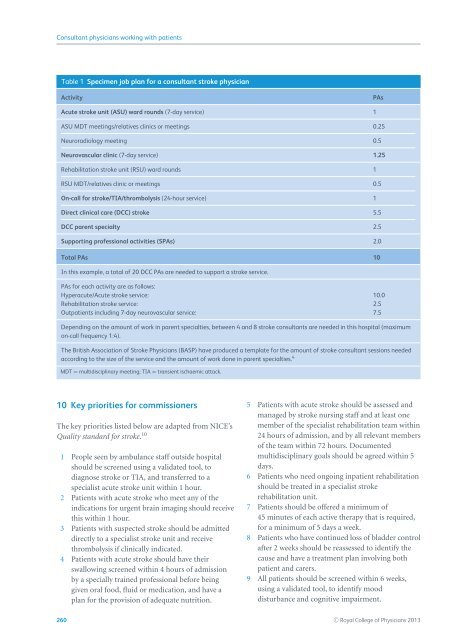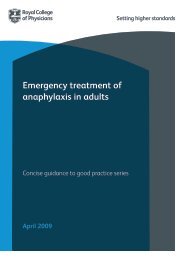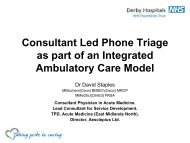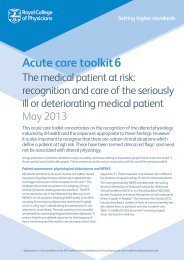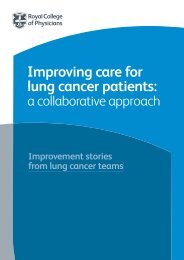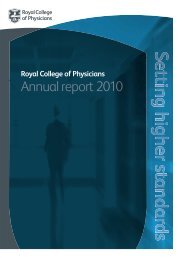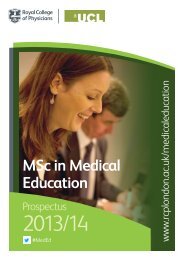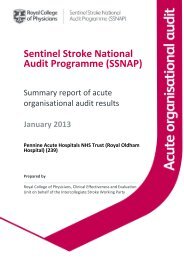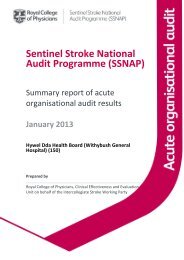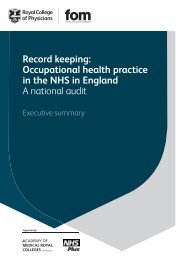Consultant physicians working with patients - Royal College of ...
Consultant physicians working with patients - Royal College of ...
Consultant physicians working with patients - Royal College of ...
Create successful ePaper yourself
Turn your PDF publications into a flip-book with our unique Google optimized e-Paper software.
<strong>Consultant</strong> <strong>physicians</strong> <strong>working</strong> <strong>with</strong> <strong>patients</strong>Table 1 Specimen job plan for a consultant stroke physicianActivityPAsAcute stroke unit (ASU) ward rounds (7-day service) 1ASU MDT meetings/relatives clinics or meetings 0.25Neuroradiology meeting 0.5Neurovascular clinic (7-day service) 1.25Rehabilitation stroke unit (RSU) ward rounds 1RSU MDT/relatives clinic or meetings 0.5On-call for stroke/TIA/thrombolysis (24-hour service) 1Direct clinical care (DCC) stroke 5.5DCC parent specialty 2.5Supporting pr<strong>of</strong>essional activities (SPAs) 2.0Total PAs 10In this example, a total <strong>of</strong> 20 DCC PAs are needed to support a stroke service.PAs for each activity are as follows:Hyperacute/Acute stroke service: 10.0Rehabilitation stroke service: 2.5Out<strong>patients</strong> including 7-day neurovascular service: 7.5Depending on the amount <strong>of</strong> work in parent specialties, between 4 and 8 stroke consultants are needed in this hospital (maximumon-call frequency 1:4).The British Association <strong>of</strong> Stroke Physicians (BASP) have produced a template for the amount <strong>of</strong> stroke consultant sessions neededaccording to the size <strong>of</strong> the service and the amount <strong>of</strong> work done in parent specialties. 4MDT = multidisciplinary meeting; TIA = transient ischaemic attack.10 Key priorities for commissionersThe key priorities listed below are adapted from NICE’sQuality standard for stroke. 101 People seen by ambulance staff outside hospitalshould be screened using a validated tool, todiagnose stroke or TIA, and transferred to aspecialist acute stroke unit <strong>with</strong>in 1 hour.2 Patients <strong>with</strong> acute stroke who meet any <strong>of</strong> theindications for urgent brain imaging should receivethis <strong>with</strong>in 1 hour.3 Patients <strong>with</strong> suspected stroke should be admitteddirectly to a specialist stroke unit and receivethrombolysis if clinically indicated.4 Patients <strong>with</strong> acute stroke should have theirswallowing screened <strong>with</strong>in 4 hours <strong>of</strong> admissionby a specially trained pr<strong>of</strong>essional before beinggivenoralfood,fluidormedication,andhaveaplan for the provision <strong>of</strong> adequate nutrition.5 Patients <strong>with</strong> acute stroke should be assessed andmanaged by stroke nursing staff and at least onemember <strong>of</strong> the specialist rehabilitation team <strong>with</strong>in24 hours <strong>of</strong> admission, and by all relevant members<strong>of</strong> the team <strong>with</strong>in 72 hours. Documentedmultidisciplinary goals should be agreed <strong>with</strong>in 5days.6 Patients who need ongoing inpatient rehabilitationshould be treated in a specialist strokerehabilitation unit.7 Patients should be <strong>of</strong>fered a minimum <strong>of</strong>45 minutes <strong>of</strong> each active therapy that is required,for a minimum <strong>of</strong> 5 days a week.8 Patients who have continued loss <strong>of</strong> bladder controlafter 2 weeks should be reassessed to identify thecause and have a treatment plan involving bothpatient and carers.9 All <strong>patients</strong> should be screened <strong>with</strong>in 6 weeks,using a validated tool, to identify mooddisturbance and cognitive impairment.260 C○ <strong>Royal</strong> <strong>College</strong> <strong>of</strong> Physicians 2013


